Taking Risks with Watercolour Paintings
Nov 13, 2022November 13, 2022
I first met Jill when she contacted me via email to ask if I would consider teaching in Wales. Within two weeks time, the workshop was scheduled for the following year (2016) the location booked and the class filled. I've been returning to Wales ever since. Not only is Jill a remarkable organizer who gets things done without delay, she is also my favorite kind of artist, one who is always looking for new approaches to creating art and seeing the world through different filters. Over the years, we've become close friends and marvelous travel companions.
During my last visit to the UK in 2021, Jill and I began a collaborative book project based on several of the lessons presented in Tansy Hargan's online workshops. We each had three, double-spread pages. The first step was to create a column of line sketches of some sort in either pencil or pen. We then mailed our pages across the Atlantic for step two. Step two was to create a column of collages inspired by the other's line sketches. Once again, the pages were sent across the ocean, one set going east and the other going west. Step three was to create a column of painted thumbnails, interpreting the previous two columns. Again, across the ocean they went. The final stage was a full-page interpretation and response to the nine thumbnails. Jill sent her completed three pages east. I packed all six almost-completed pages into my carry-on and flew west across the ocean a month ago. Yesterday, sitting at Jill's table as the autumn colours still clung to the branches outside the window, tossing in the wind, I completed my pages. I've shared all six, double-spreads in the video above as well as below.
The following three pages: Line sketches (Jill). Collage (Chris) Painted Thumbnails (Jill) Full-page Paintings (Chris)
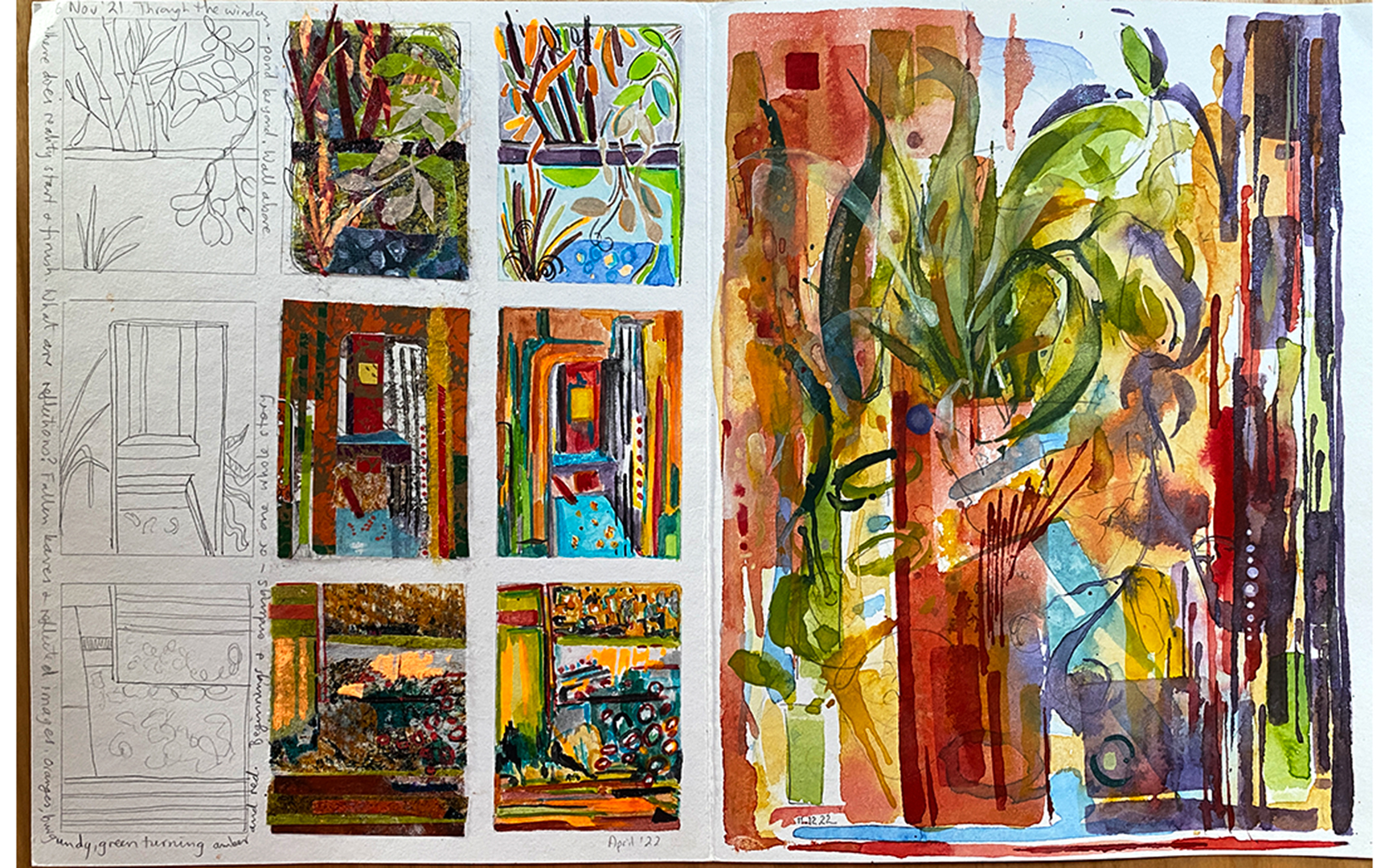
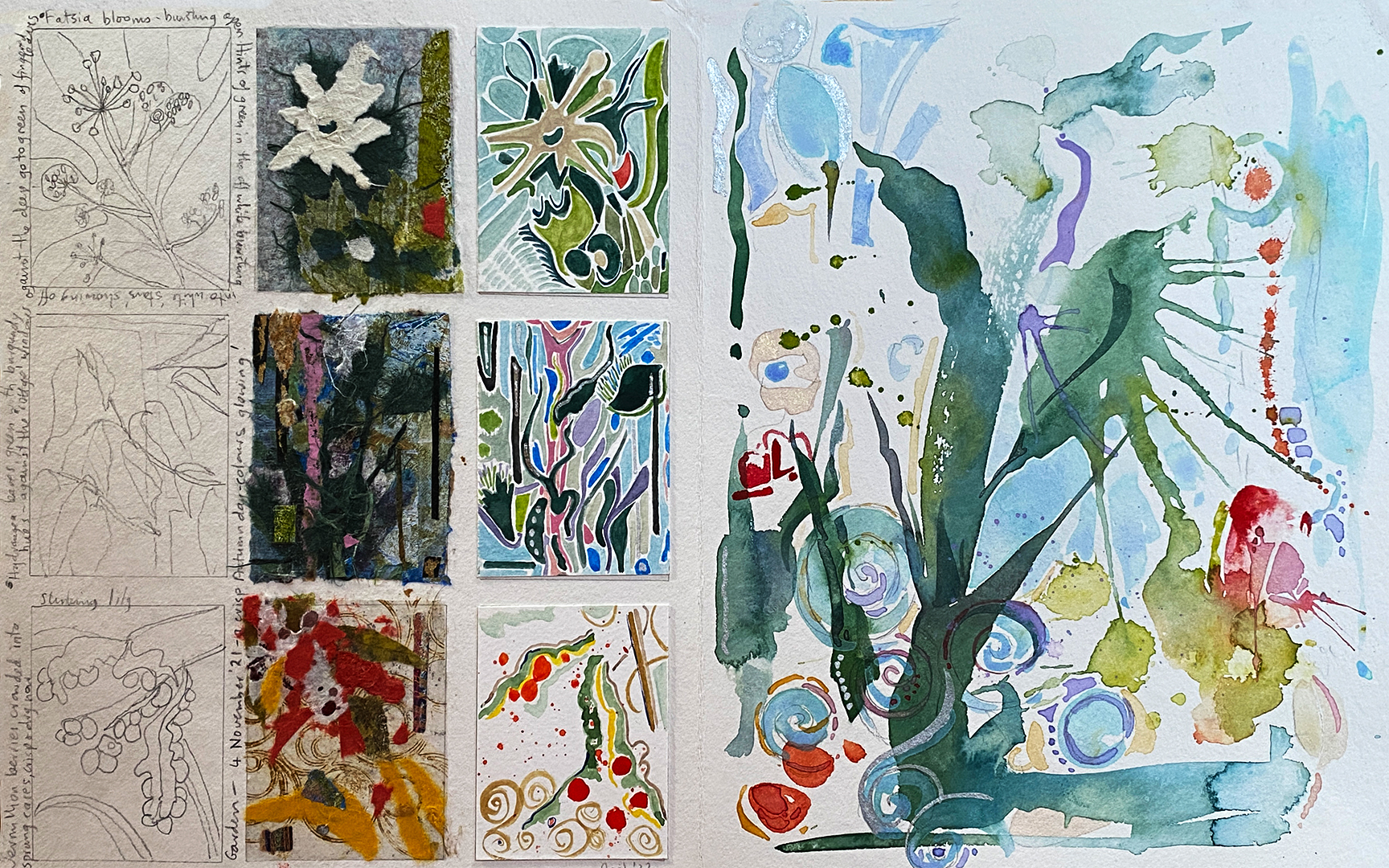
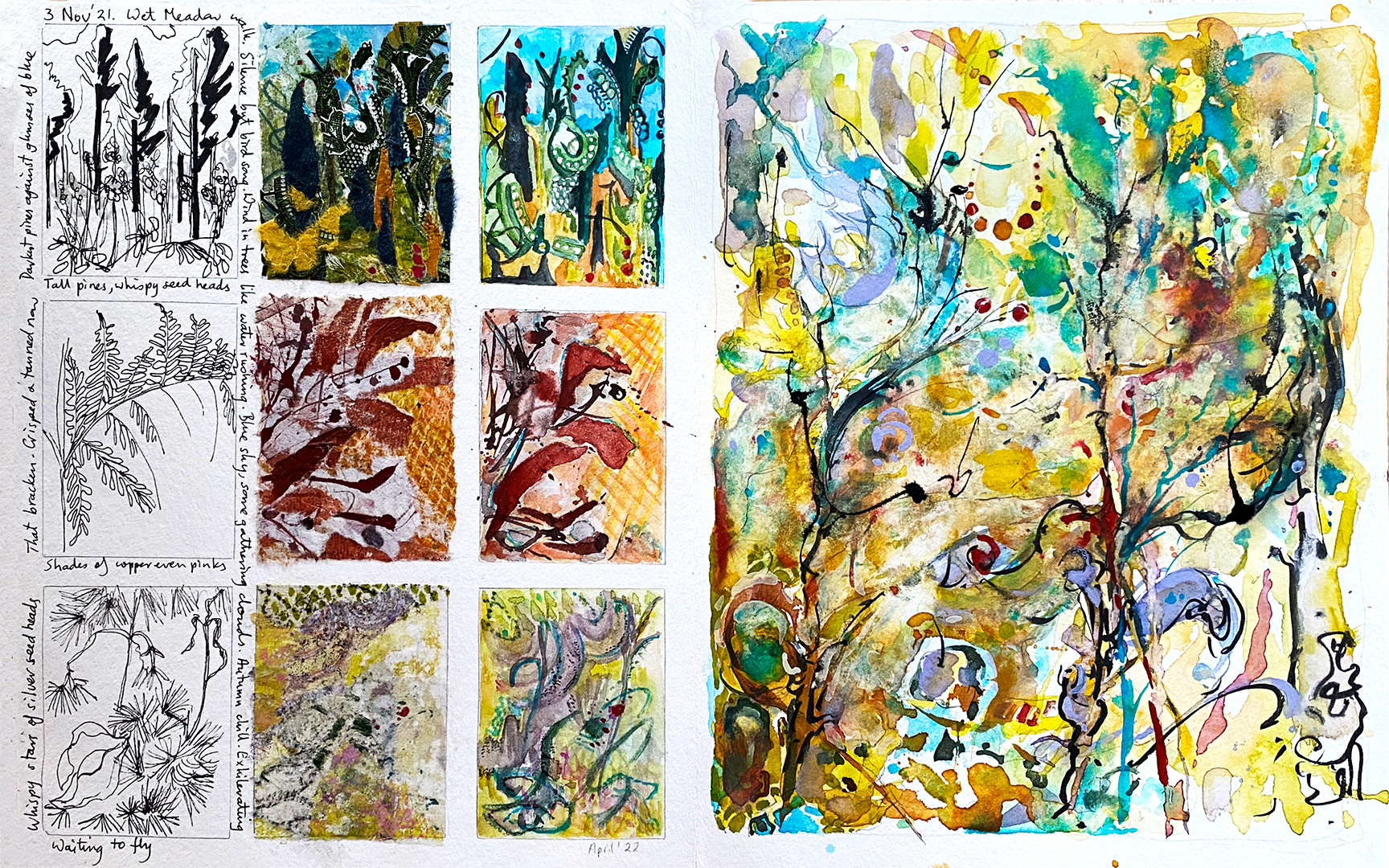
The following three pages: Line sketches (Chris) Collages (Jill) Thumbnail Paintings (Chris) Full-page Paintings (Jill).
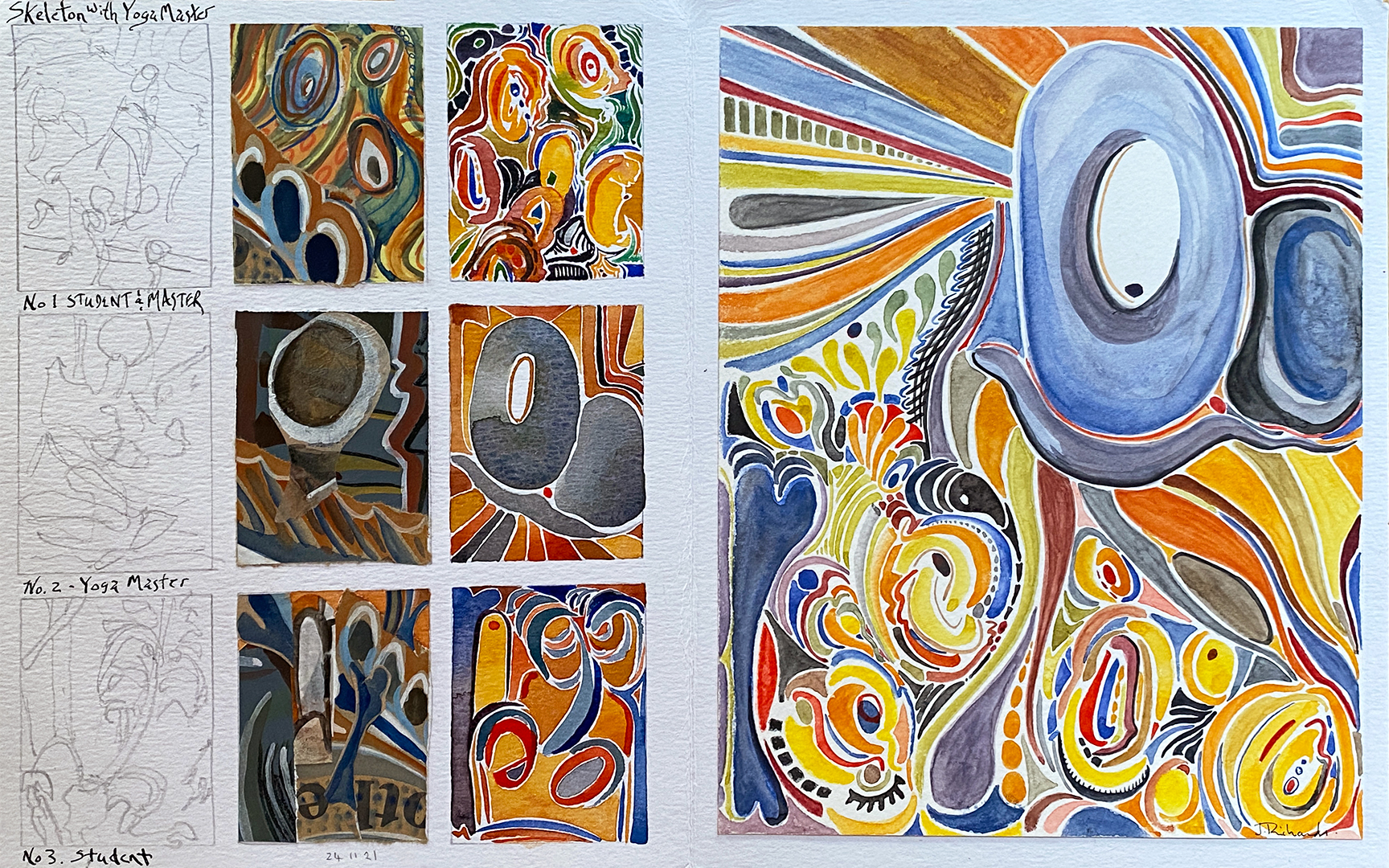
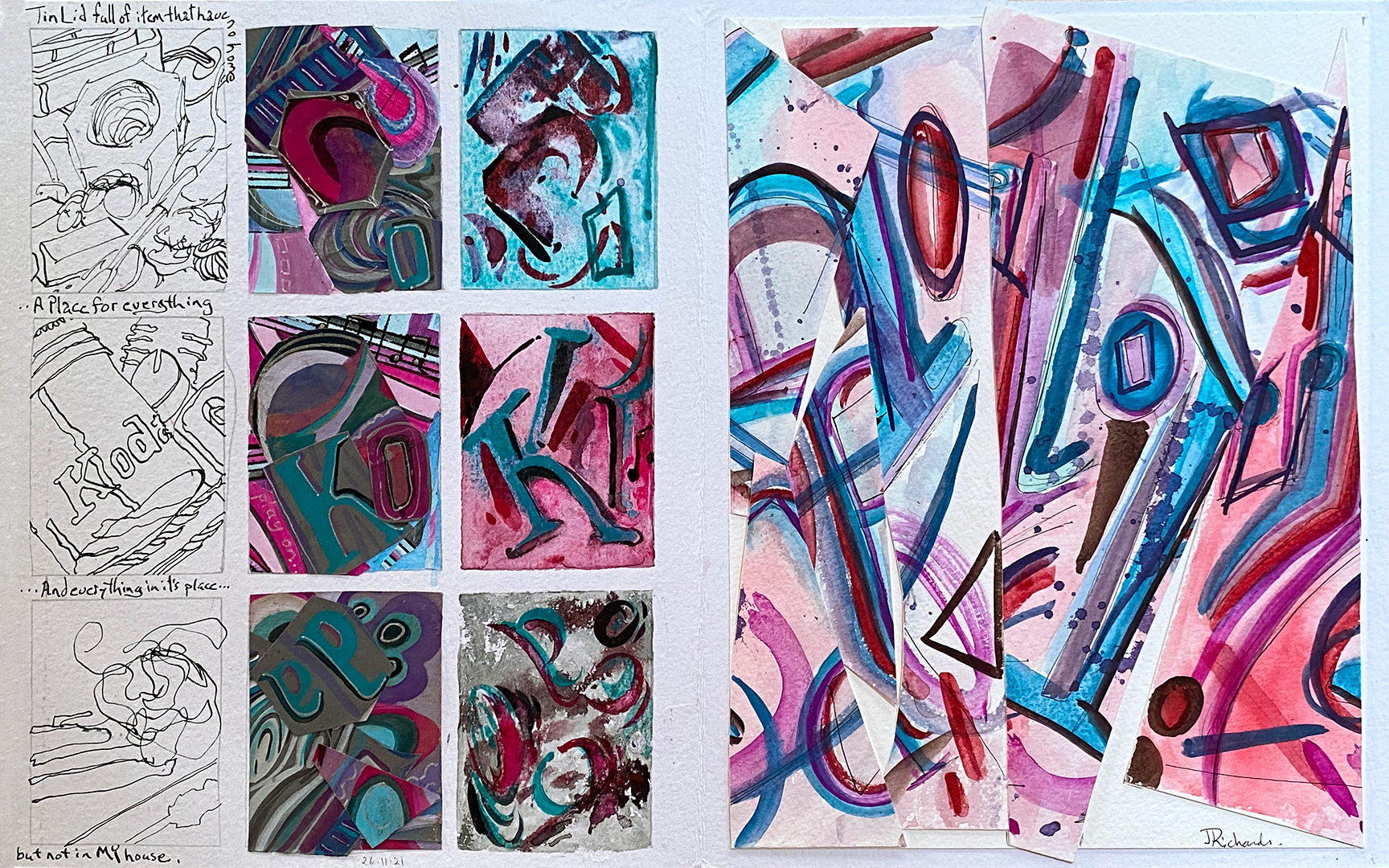
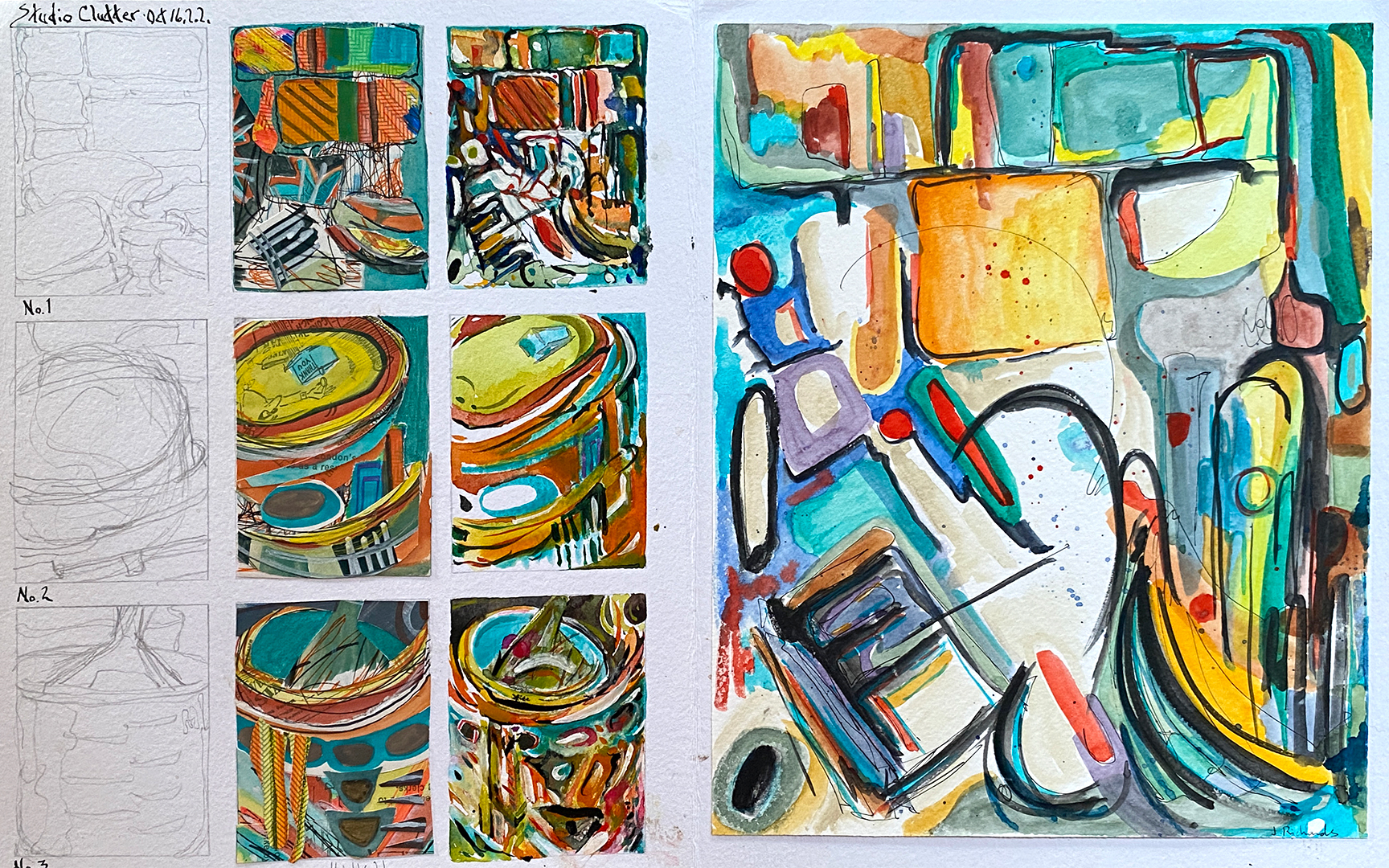
I want to mention another Tansy Hargan influence. Tansy introduced the notion of focused colour-mapping to me. It has made such an impact on the manner in which I incorporate colour into my creative process that I have expanded the idea of colour-mapping into the way I see and interpret almost everything around me. It's an approach to unraveling the mysteries, richness, complexities, flexibility and infinite possibilities that are calling out to us as artists to explore, experiment with and use in our work.
Why am I now teaching workshops focused on colour-mapping, presenting a practice that works in complete opposition to all of my other courses? Simply because it is exactly that, a backwards approach to creating a work of art.
In most of my other workshops I present the process as follows:
Shape: Make sure that your basic shapes are shapes that please you. A shape that is unpleasant to your eye will always be unpleasant to your eye no matter how you try to camouflage it with good choices of value (tone), great textures, expressive lines and beautiful colours. Make sure you vary the sizes of your basic shapes.
Value: Be aware of how you distribute values (tones) to your shapes. Do the values alter the basic shapes because they are so close in value that two shapes become one? Do the values convey the mood you wish to achieve. Do you want to use a wide range of values (white to black) or a narrow range of values (mostly light, mostly mid-tone or mostly dark tone)?
Temperature: Which shapes do you want to be cool and which shapes do you want to be warm? Do you want to combine warms and cools of the same value within a basic shape such as in a hillside of trees that are of a similar value?
Texture: How much texture do you want in your piece? What sort of texture do you want and what are you wanting to communicate with the texture?
And finally ... the icing on the cake ... the last thing to focus on once the cake has cooled ... COLOUR!
Well ... by the time we get to colour, almost everyone is on overload, exhausted, craving for either another cup of powerful coffee or an entire bottle of wine. Some artists are still fussing over their drawing, getting caught up with the details of the buttons on a shirt or an eye that isn't sitting quite properly within the eye socket beside a nose that ends up being far too small for the head.
No matter how often I emphasize the importance of a daily practice of drawing, simply taking pencil, pen or brush in hand to make marks on a piece of paper, I find it to be one of the biggest stumbling blocks in a workshop. Drawing, whether representational or abstract takes practice to find your own path toward personal creativity. Colour will not make up for drawing that you feel is inadequate. And ... you don't need to "draw well" to make fabulous art. When drawing skills don't please you, you have two choices. You either practice and strengthen your drawing skills or you jump forward and enjoy simple mark-making, focusing instead on the shapes you make on your canvas and gorgeous colour. Be playful!
Value (tone) can be extremely challenging, especially when it comes to colour value. To some artists, this comes naturally. For me, it definitely did not. It is my many years of working in black and white photography that taught me to see the technicolor world in grayscale. I am forever grateful for that training.
The colour-mapping workshop is presented in reverse. We begin with looking only at colour, skipping the drawing, skipping the basic shapes, skipping the tonal values and skipping choices regarding texture. We are only looking at and identifying colour! What ends up happening is that by looking hard at what we see, we observe more carefully. We observe the saturation of a colour, the value of a color, the hue of a colour and the temperature of a colour. As we are mapping, we notice the dominance of certain colours, the dominance of values, temperatures and saturations. We notice how we feel about the colours and how they effect us emotionally. We discover a world of colours far more vast and filled with possibilities than we thought possible. We get to experience these pleasures and discoveries when we are still clear-headed and energetic rather than only capable of slopping the icing onto the cake to present it to others, hoping they'll enjoy a painting that no longer excites us.
What does this have to do with the collaborative book? Everything. A collaboration is an exchange of ideas, processes, viewpoints and perspective. As artists, seeing in a new way, through different filters, keeps us creating rather than slipping into the mode of manufacturing art. I encourage artists to keep visiting art they are uncomfortable with, to continue to take classes to throw them off guard and to be forced, once again to be a student, a novice of one sort or another.
I was inspired to write this rambling blog because of the frustrating experience I had yesterday when painting the last page of our collaborative book. The piece was "finished" at least six times ... and it bored me to death. I was frustrated, not wanting to disappoint Jill with a tired, uninspired painting. Yes, each time it arrived at that point where i could call it finished, it clearly related to the previous nine sketches. But ... it had no soul. It had strong basic shapes, strong values, good temperature choices, good textures and expressing lines. And ... it was without energy. The paper was wearing thin and my jaw was becoming tense.
In the evenings, after supper, Jill and I have been watching an online workshop presented by Jenny Nelson. She was altering her students work in ways I would never have done. Many of the choices I definitely would not have made. Sometimes I ended up really liking the results, other times I didn't. What did I have to lose by trying something I thought to be a really bad idea? I slipped into what I imagined may go on in the space behind Jenny Nelson's eyes and obliterated my favorite parts of my painting. I wanted to rip off the page, apologize to Jill and go to bed early.
For the next hour I dug into my painting as if I were a bird building its first nest. I now find the painting to be my favorite of my three, a nest I feel quite proud of having built. It is more painterly and a better reflection of my inner artist. For some peculiar reason, it has captured my experience of childhood fairytales ... the magic, mysteries, terrors and delights.
Many of the colour choices I made along the long path to resolution of this painting, I would never have made if it hadn't been for a year of colour-mapping en plein air as well as in my studio.
Thank you, Jill, Tansy, Jenny, and of course Sally Hirst who completely altered my process of working in my studio.
See below for a few of the Found Compositions I discovered within my last painting.
Thank you for reading my blog.
Chris

full image
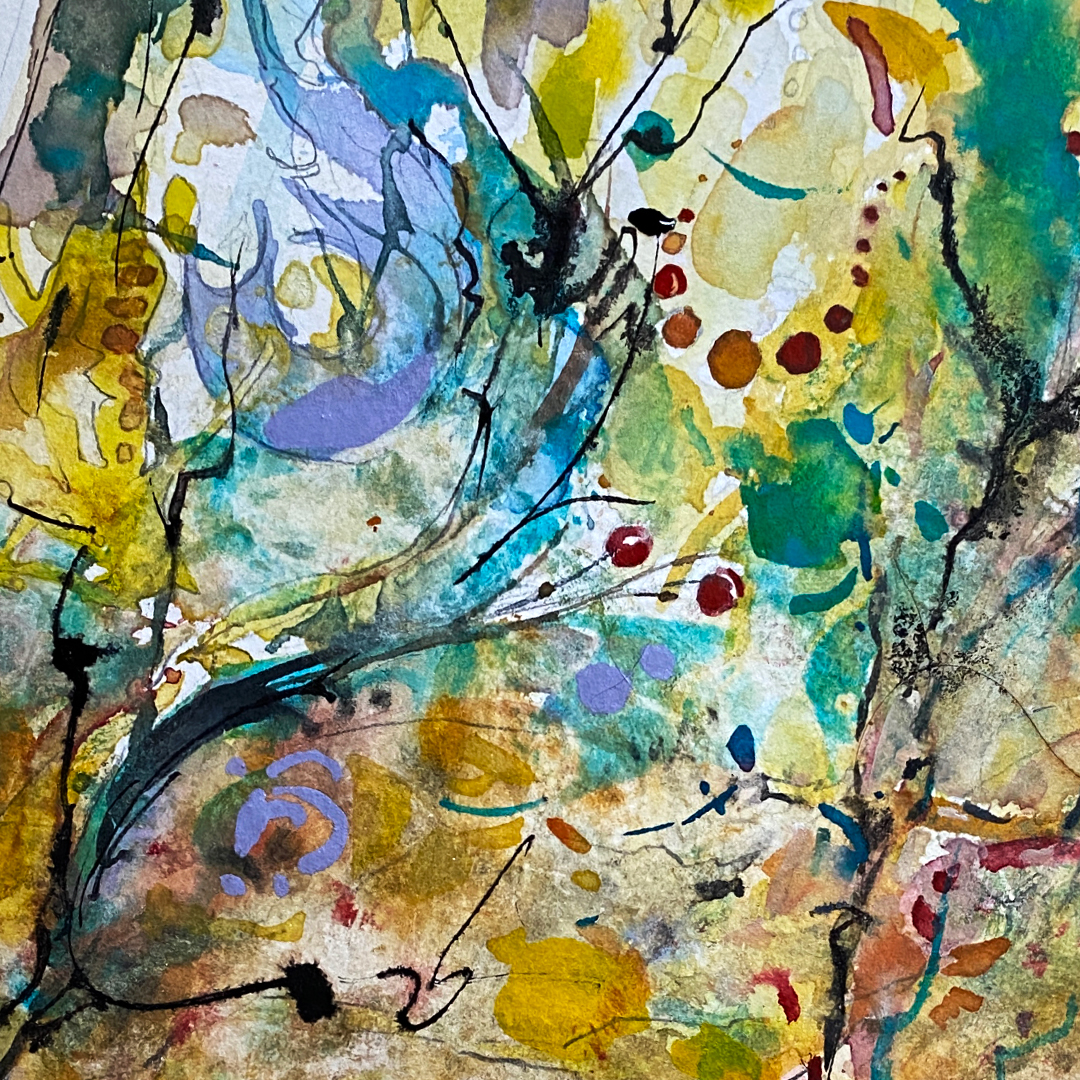
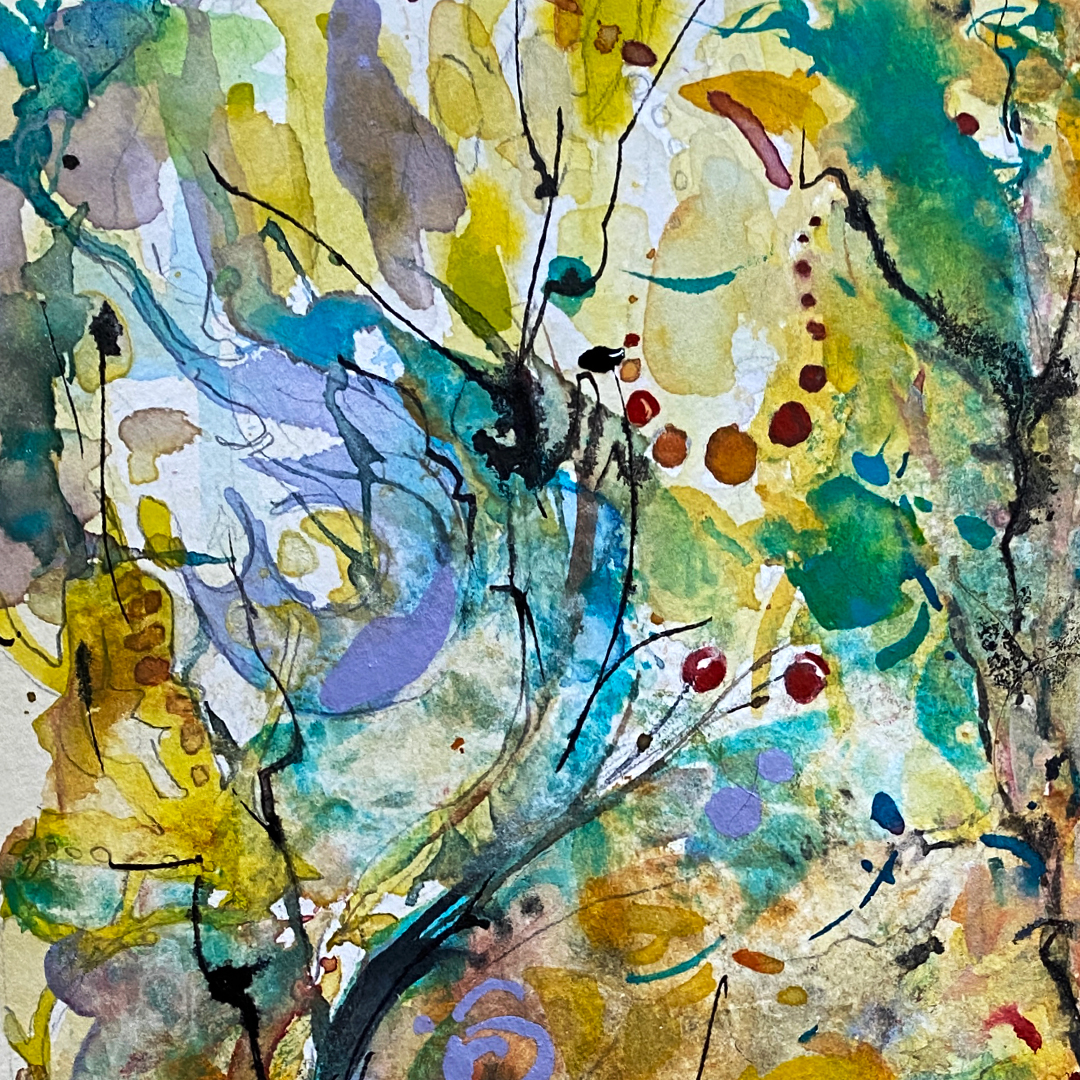
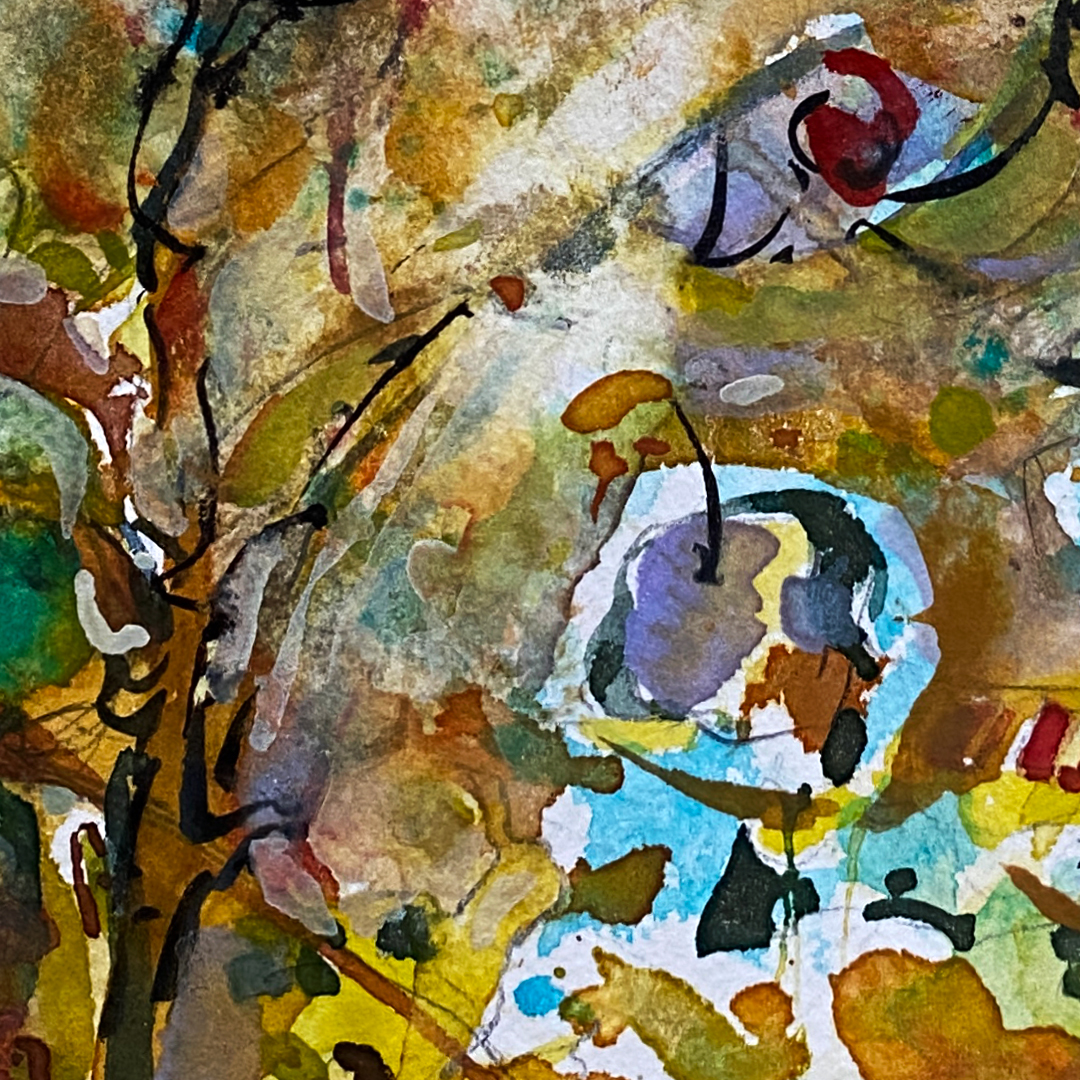
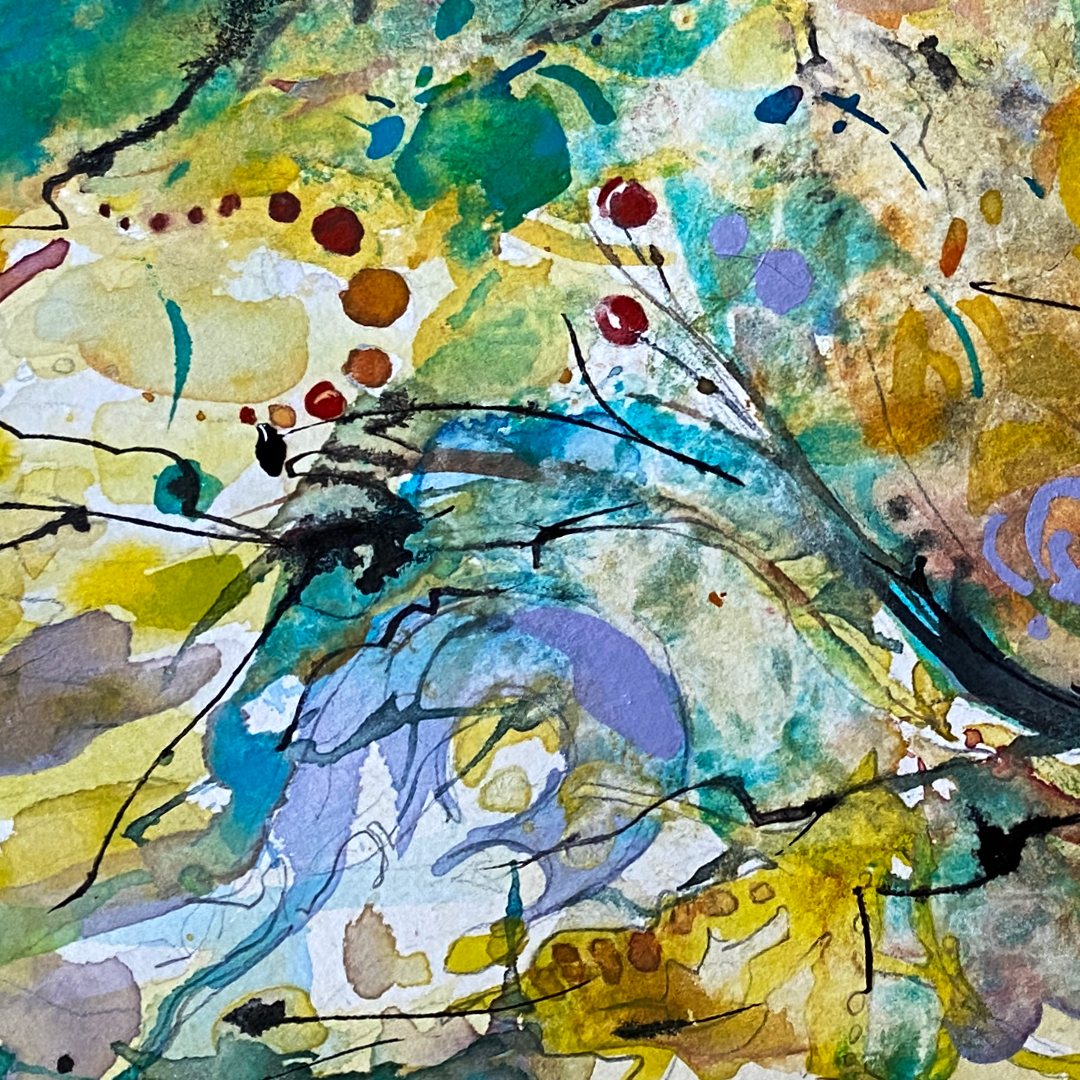
Subscribe
Join my mailing list to receive notification of new blog posts and update on the online courses.
Don't worry, your information will not be shared.
We hate SPAM. We will never sell your information, for any reason.
